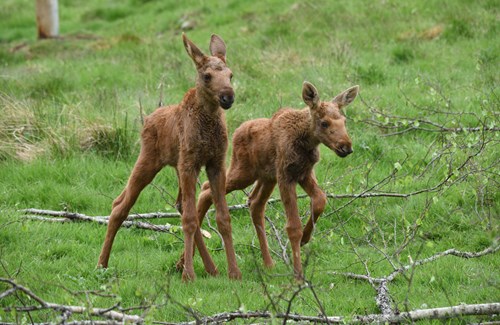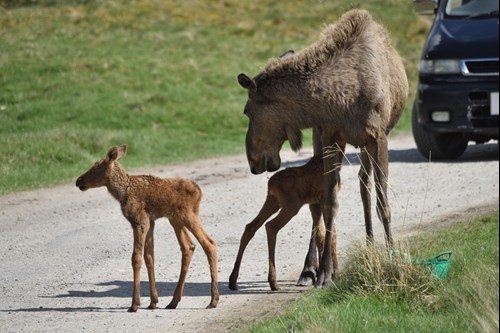Doubly elk-citing new arrivals
02/06/2016 in Highland Wildlife Park

As the warm weather has arrived, so it seems has the annual birthing season at RZSS Highland Wildlife Park. The latest new arrivals in the Highlands are two elk twins, born on 15 May. With their long, gangly legs and adorably oversized ears, the youngsters are already stealing visitors’ hearts.
Elk became extinct in Scotland between 1,000 and 7,000 years ago, and are a perfect fit for the Highland Wildlife Park, which specialises in native species past and present, as well as cold tundra animals from around the world. Elk can still be found in woodlands in the northern hemisphere, throughout Scandinavia and northern Russia. What we call elk, the North Americans call moose, and the two animals are very closely related. Elk are particularly good at running for long periods of time, fighting off predators (due to their size and powerful kicks) and swimming.

Morag Sellar, Head Hoofed Stock Keeper at RZSS Highland Wildlife Park, said: “The twins are still a little shaky on their long legs, but they are already able to keep up with their mother Cas and run around for short distances. The youngsters will continue to suckle for the next five months whilst learning to forage. Although small now, they will grow to an impressive ten times their birth size.
“We are particularly proud of our success with elk which was acknowledged at last year’s BIAZA (British and Irish Association of Zoos and Aquariums) Awards, where the Park received a silver award for the captive husbandry of European elk/moose."
Elk are the largest living deer species, growing up to two metres tall and the males can reach weights of up to 720 kg. Males are striking due to their large antlers that grow throughout the summer months; initially covered in skin, known as velvet, this is later rubbed off and then the antlers are shed in winter. These amazing antlers can span up to two metres across and weigh as much as 30 kg.
The twins and their parents can be seen in the main drive-through reserve at RZSS Highland Wildlife Park.
Featured Articles

An update from the Budongo Forest
19/04/2024 in Conservation

Edinburgh Zoo named best zoo in Scotland
15/04/2024 in Edinburgh Zoo

























Follow EZ